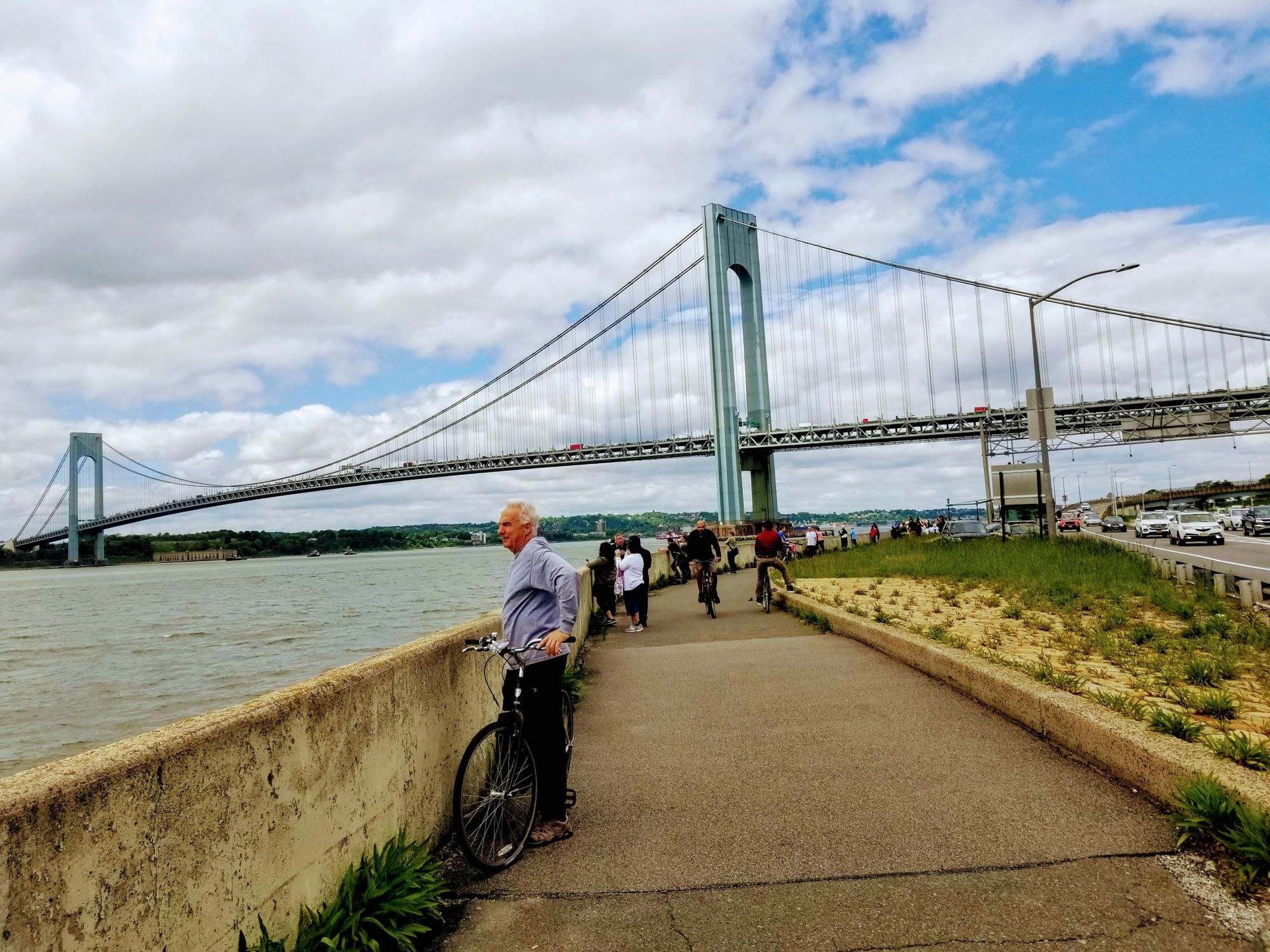Activists Relaunch Campaign for Bike and Pedestrian Access on the Verrazzano Bridge, MTA Resistant


Once again, a coalition of cycling and safe streets activists call for cyclist and pedestrian access on the Verrazzano-Narrows Bridge. But despite support from local elected officials, the MTA, which controls the bridge, remains opposed to the proposal.
On Saturday, citing the city’s pandemic-induced cycling boom, a coalition of activist groups including Transportation Alternatives, Bike South Brooklyn, and the Harbor Ring held a virtual event to “relaunch” an existing campaign to convert one of the bridge’s 13 traffic lanes for use by cyclists and pedestrians. At the event, representatives played a video showcasing support by residents and called Governor Andrew Cuomo and the MTA to make the change.
“We believe there are environmental benefits to getting this done, in lessening congestion on roads leading up to and going from the bridge,” said Rose Uscianowski, Transportation Alternatives’ Staten Island Organizer. “We believe there are public health benefits. We believe that there is the opportunity to bring in more tourism to south Brooklyn and to the North Shore and Mid-Island. We believe there are benefits to local businesses. This would obviously be great for recreational uses. I mean, the benefits go on and on.”
The date of the event, November 21st, was not selected randomly; it was the 56th anniversary of the Verrazzano’s completion in 1964. And though Transportation Alternatives has advocated for bike and pedestrian access to the bridge for nearly a decade, frustration with the bridge’s car-only design stretches back to the very day it opened.
“How’s a Brooklyn lady who likes to walk supposed to enjoy the country life of Staten Island?” asked one woman quoted by the New York Times in an article published shortly after the bridge was completed.
At the time, officials cited cost as the reason not to include a crosswalk. Today, they cite congestion.

“Traffic on our Bridges and Tunnels is back to near pre-pandemic levels,” said Meredith Daniels, a spokesperson for the MTA. “There is no spare capacity on the bridge to take away a lane from motor vehicles without gridlocking the bridge for bus customers and motorists.”
Daniels said the MTA installed bicycle racks on the S53 and S93 buses, which cross the bridge, as a way to enable cyclists to travel between Brooklyn and Staten Island.
But, just as in 1964, the stated reasons for failing to include a crosswalk may paper over other concerns. Back then, engineers worried that allowing pedestrians to access the bridge could facilitate suicides. Now, the MTA faces a punishing fiscal crisis and likely fear the reduction of toll-paying car crossings on the bridge could further impact their bottom line.
“There’s no monetary benefit for them to add this access, and so they have no reason to listen to us,” Uscianowski said. “They need that pressure from above.”
A spokesperson for Cuomo, who controls the MTA, directed a request for comment back to the transit agency. But the proposal has the support of several city and state elected officials from the area, particularly on the Brooklyn side of the bridge. Council Members Justin Brannan and Carlos Menchaca, State Senator Andrew Gounardes, and State Assemblymember Mathylde Frontus all said they favored the proposal.
“Since its opening, New Yorkers on both sides of the Verrazzano-Narrows Bridge have been fighting to make the bridge accessible to pedestrians and cyclists,” Frontus said in a written statement. “Robert Moses’ ambitious but limited design left no room for anything other than cars and trucks. But we cannot be trapped by an outdated and failing transportation model. All roads are shared roads. It is time to create a pedestrian and bike path on one of the bridge’s 13 lanes. The climate crisis, economic uncertainty, and the struggles of our mass transit systems demand that the Verrazzano be accessible to all.”
On Staten Island, the more car-centric of the two boroughs, support was more qualified.
“I am open to the addition of a separate bicycle and pedestrian path on the Verrazzano, as long as engineers can address safety and structural concerns, specifically the real dangers posed by wind shear on the bridge,” said Council Member Steven Matteo, the Council’s Republican Minority Leader, whose district includes the Staten Island side of the bridge. “However, given the agency’s dire fiscal situation, priority must first go to completing the suicide prevention barriers that the MTA and I have worked on for years, as well as to funding basic transportation operations and maintenance.”
Assemblymember Nicole Malliotakis and State Senator Diane Savino did not respond to requests for comment, nor did Michael Tannousis, who will succeed Malliotakis in Staten Island’s 64th Assembly District. Staten Island remains the only borough without a bike share program, though that is expected to change in March when the city will launch a 350-bike program on the borough’s North Shore.
Beyond the communities immediately adjacent to the bridge, advocates see a Verrazzano bike lane as the keystone in a wider effort known as the Harbor Ring, which would link portions of New Jersey, Manhattan, Staten Island, and Brooklyn facing the New York Harbor with a single bike and pedestrian greenway.
“Right now, the harbor can divide us, especially those of us without access to cars,” said Daelin Fischman, a member of the Harbor Ring Committee. “The Harbor Ring re-envisions the harbor as a place for everyone.”





